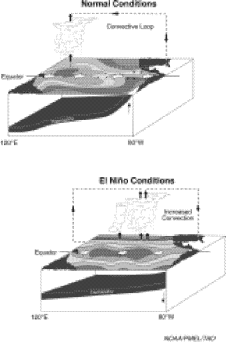

|
El Nino brrrrr-ings back nice weather |

Dr. Gordon Swaters |
The warm, dry December we enjoyed was caused by the weather phenomenon, El Nino, says mathematical sciences professor Dr. Gordon Swaters, not by global warming. "People shouldn't think El Nino is the result of humans forcing of the climate system. It isn't anything out of the ordinary.
As long as we have been able to keep records and probably before, El Nino has been occurring."
The first clear observation of El Nino seems to have been recorded about 400 years ago, Swaters says. South American fisherman noticed the tiny anchovies that usually teemed in the coastal waters would periodically disappear. The fish seemed to vanish every few years around Christmas, bringing the fishing business to a sloshing halt.
Swaters - who jokes that by virtue of the 'water' in his name, he was doomed to do fluid dynamics - has studied the El Nino phenomenon. His research team is trying to understand the stability of large scale flows in the ocean and in the atmosphere. In fact, the University of Alberta's math department is the only one in the country to have its own fluid dynamics lab.
"We understand the what of El Nino," Swaters says, "we don't understand the why." We know that El Nino is a "lovely coupling between the currents in the tropical Pacific Ocean and the winds which blow above." As for why it happens in five to seven year cycles, however, Swaters admits it's still a mystery.

|
What is clear, he says, is that El Nino occurs when the trade winds, which create westward flowing ocean currents, suddenly stop - and it only happens in the Pacific Ocean. Speculation among researchers is that the Atlantic Ocean is too narrow to allow this effect.
Typically, Swaters explains, Pacific trade winds blow from east to west across the oceans, creating currents which travel from South America over to Southeast Asia. The water literally piles up in the western Pacific. "So if you thought about it," Swaters says, "the surface of the ocean is a bit like a tilted plane where the water is higher in Asia than it is in South America." (The effect is similar to a fan blowing across a bathtub full of water).
Then, "for reasons we don't understand, these winds stop. They just subside. So the force which created this incline is now gone." With nothing to hold it up, the water rushes back to the opposite shore, like the water in the bathtub would if the fan were suddenly switched off. (That explains the South American anchovy disappearance - they don't like the warm water returning from Southeast Asia).
The maximum effect is around Christmas, hence the name El Nino, Spanish for "little one."
The effects of El Nino can reach across the globe because of the enormous redistribution of warm ocean surface water. That, in turn, affects winds throughout the world. In our case, El Nino typically makes winters milder because the jet stream is pushed northward, allowing warmer southern air to cover us.
Occasional very cold air will still creep in, but El Nino will shorten its duration.
"We're in a nice part of the world for this," Swaters say. "We benefit from El Nino. Our winters are less severe." Other parts of the world also feel the impact of El Nino - but with disastrous results: "Over in Indonesia and Australia, they have horrible forest fires because the conditions become very dry since the amount of rainfall they get is diminished. And we think that the severity of the ice storms in Eastern Canada could be related to El Nino."
By disrupting normal agricultural systems and causing property damage, El Nino has profound economic influence, Swaters says, about 10 billion dollars in a given year.
"Maybe what we should do - because we're never going to stop it, forget it - is plan for it." Swaters says. "By better understanding the dynamical processes resulting in El Nino, maybe we can make better predictions about when it will occur and what will be the impacts." We know from past history that during El Nino winters the risk of forest fires in Southeast Asia increases.
Swaters notes there are predictable benefits to El Nino as well. Wheat production seems to be enhanced in Western Canada in the years following El Nino; "maybe farmers could exploit that."
We can't stop El Nino, but it seems we can speed it up. Swaters says El Nino's five to ten seven year cycle may be shortening and the increase, not the El Nino itself, may be due to global warming.
The next El Nino should blow into town sometime over the next seven years, although Swaters says there's no way to say for sure. "It could be next year, but it could also be a decade away."
![[Folio]](http://www.ualberta.ca/~publicas/folio/gif/small/folio.gif)
Folio front page |
![[Office of Public Affairs]](http://www.ualberta.ca/~publicas/gif/small/opahome.gif)
Office of Public Affairs |
![[University of Alberta]](http://www.ualberta.ca/~publicas/gif/small/uahome.gif)
University of Alberta |